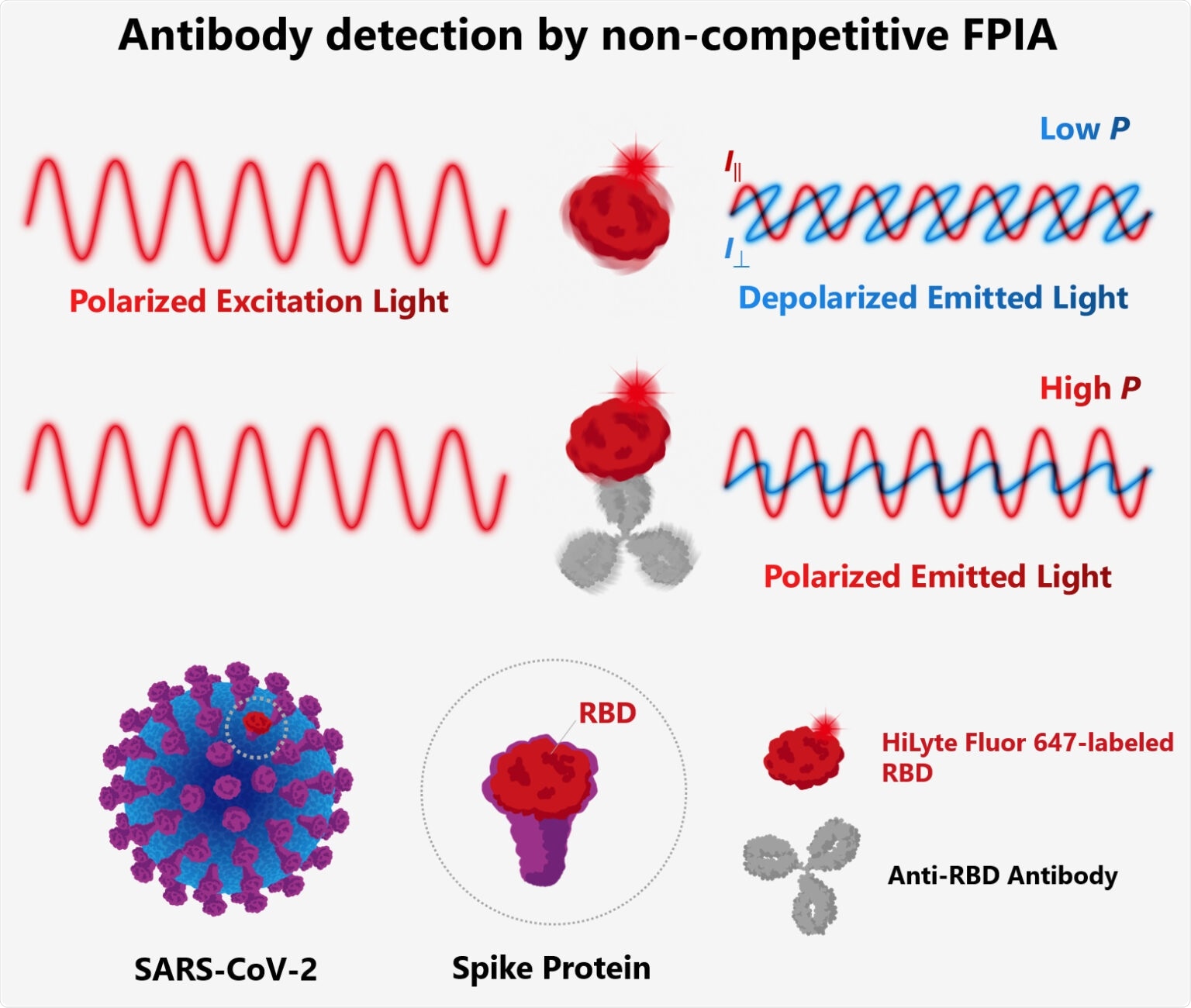Japanese researchers, including Professor Manabu Tokeshi of Hokkaido University’s Faculty of Engineering, have come up with a highly accurate, rapid test for identifying antibodies against the SARS-CoV-2 spike protein in human serum.

The principle behind FPIA for detection of antibodies against SARS-CoV-2. When free fluorescently-labeled recombinant SARS-CoV-2 spike proteins (F-RBD) are exposed to a specific wavelength of polarized light, they emit depolarized light. However, if F-RBD are bound to anti-RBD antibodies, they emit polarized light instead, which can be measured. Image Credit: Keine Nishiyama, et al., Biosensors and Bioelectronics, June 5, 2021.
The breakthrough paves a new way for gaining insights into the complete extent of the pandemic and assessing the effectiveness of vaccines.
Since the advent of the Covid-19 pandemic, the 18-month period has evidenced major efforts in the discovery and invention of different strategies to monitor and control the spread of the SARS-CoV-2 virus. Therefore, fast and accurate diagnosis has always been crucial.
The RT-PCR method has been the gold standard since the start of the pandemic. But it is labor-intensive, time-consuming, and necessitates advanced equipment. Moreover, it can only identify the presence of viral RNA in the samples.
The Japanese scientists devised a 20-minute test to identify and measure antibodies against SARS-CoV-2 in human serum. The study results were reported in the Biosensors and Bioelectronics journal.
Researchers estimate that about 40%–45% of individuals infected with SARS-CoV-2 remain asymptomatic—despite their infection, they do not present with any symptoms of the disease. It is crucial to identify individuals who may have had asymptomatic Covid-19 to fully understand the extent of the pandemic.
RT-PCR can identify only the presence of the viral RNA in samples but cannot detect the antibodies to the virus found in individuals who have recovered from the pandemic.
Although commercial tests are available to identify whether antibodies against SARS-CoV-2 are present, a majority of such tests are inaccurate. One of the most prevalent tests for diagnosing Covid-19 based on antibody detection is the lateral flow immunoassay.
This method is very fast but cannot be used to quantify antibodies as it is a qualitative method. Moreover, the method does not scale well, leading to reduced cost-effectiveness.
The researchers came up with a new method for detecting antibodies against SARS-CoV-2 in human serum, which involves using non-competitive fluorescence polarization immunoassay (FPIA).
Apart from being rapid, it can even be used for quantifying the antibodies. FPIA finds use in the food and medical industry. The researchers earlier made several optimizations to the method and related equipment, such as the development of a portable fluorescence polarization analyzer.
For performing the FPIA test, fluorescently-labeled recombinant SARS-CoV-2 spike proteins (F-RBD) should be mixed with human serum. The serum of individuals infected with or vaccinated against SARS-CoV-2 will have anti-spike protein antibodies.
Binding of these antibodies to F-RBD results in the emission of polarized light. By contrast, F-RBD alone leads to the emission of depolarized light. Measurement of the degree of polarization with a fluorescence polarization analyzer helps quantify the concentration of antibodies.
The researchers made innovations to the test and assessed it with human serum samples from individuals diagnosed with Covid-19 and from those who had not been infected by SARS-CoV-2.
It was shown that the test is rapid, highly accurate, and simple to perform while ensuring high throughput. This test takes roughly 20 minutes to complete as against almost 2 hours needed for other tests. Moreover, the equipment needed for the test weighs only 4.3 kg, making it highly portable.
Collectively, all these features make the test a great option to detect and quantify antibodies against SARS-CoV-2. Currently, the test can be used for two applications: large populations can be screened to identify the exact extent of the pandemic, and the effectiveness of SARS-CoV-2 vaccines can be assessed based on the antibody response.
Source:
Journal reference:
Nishiyama, K., et al. (2021) Facile and rapid detection of SARS-CoV-2 antibody based on a noncompetitive fluorescence polarization immunoassay in human serum samples. Biosensors and Bioelectronics. doi.org/10.1016/j.bios.2021.113414.